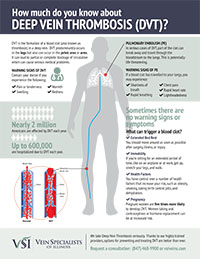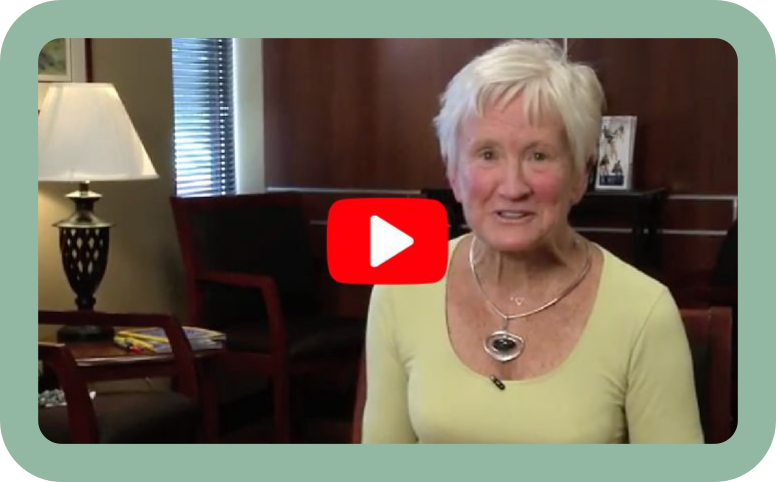Contact us today.
Are Varicose Veins an Early Warning Sign for DVT?
Are Varicose Veins an Early Warning Sign for DVT? A recent study published in the Journal American Medical Association (JAMA) found a significant association between varicose veins and deep vein thrombosis (DVT), and less clear potential associations with pulmonary embolism (PE) and peripheral artery disease (PAD).
The significance of this large, retrospective population study (over 400,000 people) is that varicose veins are a common condition but may be associated with increased health risks, especially for deep vein thrombosis (DVT). DVT, pulmonary embolism (PE), and peripheral artery disease (PAD) are all vascular diseases with severe systemic effects and may be life-threatening.
Researchers looked at the health records of more than 425,000 adults over a 12-year period. The study concluded that more work is needed to understand whether varicose veins directly cause blood clots or whether the two conditions have a similar origin due to a common set of risk factors.
The JAMA study showed varicose vein patients had about a 5 times greater risk of developing a DVT.
According to Dr. Thomas Lutz, “This robust study underscores the importance of the early evaluation of varicose veins. We always knew there was a correlation between varicose vein disease and venous thrombosis but this study suggests a much stronger correlation.”
Deep Vein Thrombosis
 March is Deep Vein Thrombosis (DVT) Awareness Month and a good time to talk about risk factors. Deep vein thrombosis, or DVT, is the formation of a blood clot inside the deeper veins of the body, especially in the legs.
March is Deep Vein Thrombosis (DVT) Awareness Month and a good time to talk about risk factors. Deep vein thrombosis, or DVT, is the formation of a blood clot inside the deeper veins of the body, especially in the legs.
A blood clot inside a vein deep in the body is called deep vein thrombosis, or DVT, and can be a complication of varicose veins when it forms in the leg. DVT may not have any symptoms but can cause pain, swelling, and warmth in the leg.
Dr. Stephen Sorenson explains, “Varicose veins are more common than people think and symptoms of a DVT can be subtle. Early ultrasound evaluation and treatment by an expert in venous disease leads to the best overall outcome.”
The veins of the legs are classified anatomically. The “deep” veins are within and below the muscles and the “superficial” veins are above the muscles. DVT (Deep Vein Thrombosis) is where a thrombus or clot obstructs a vein. It is a serious condition that can lead to disability and even death if the thrombus travels through the bloodstream to the lungs. When this happens, it is called a Pulmonary Embolus (PE).
Although most DVT resolves with appropriate management, massive pulmonary embolism causes as many as 300,000 deaths annually in the United States.
Varicose Veins
It is estimated that at least 25-35% of US population has varicose vein disease.
In addition to pain and the impact on your quality of life, varicose veins are a condition that will not get better left untreated. In fact, it will get worse over time. Without treatment, there is a risk of darkening of the skin, chronic swelling and difficult to treat open wounds called venous stasis ulcers. Ignored, it may also lead to a condition called stasis dermatitis that often causes a red rash on the legs and the skin may become shiny, hairless and develop brownish discolored areas. Watching and waiting is not an advisable course of action. The question to ask is not should you seek treatment, but when?
In healthy veins, one-way valves inside the vessel ensure that blood flows in the only direction – towards the heart.
In varicose veins, these valves fail to work properly and blood flows backward, pooling in the vein. This abnormal blood flow is called venous reflux and dilates and stretches the vein beyond its normal size. This can lead to bulging, twisted veins on the surface of the leg. Sometimes these enlarged veins are deeper inside the leg and cannot be seen on the surface of the leg but can be seen with the help of ultrasound. Either way, these varicose veins can lead to symptoms such as pain, aching, cramping, itching, burning, swelling, heaviness, tiredness, fatigue and restlessness in the legs. Many times these symptoms will be worse at the end of the day or after periods of prolonged standing.
Heredity is a primary factor in over 80% of varicose vein cases. Other contributing factors may include pregnancy, obesity, hormone therapy, standing or sitting for long periods of time and injury.
Having more than 20-years of experience treating varicose vein disease, Dr. Sorenson notes “varicose veins never get smaller and tend to become more painful with time. Painful, heavy, aching legs due to varicose vein disease are often mistaken for the normal aging’ ‘Simply getting older should not be an excuse for leg pain”
Treatment
Most people with varicose veins have a problem limited to the veins in the legs. There are, however, less common causes of leg vein problems which shouldn’t be overlooked. During your initial consultation, Drs. Sorenson and Lutz will ask questions and do an examination designed to check for these other possible causes along with her evaluation of your legs.
Diagnostic Ultrasound is a non-invasive test which allows evaluation of structures below the skin surface. It is the test of choice for evaluating vein problems. The ultrasound is performed in our office by a Registered Vascular Ultrasound Technician (RVT).
Endovenous Laser Ablation (EVLA) is one of the most effective and least invasive ways to treat the largest of varicose veins. Endovenous laser ablation has replaced traditional vein stripping procedures which are performed in a hospital, require general anesthesia, have long recovery times and higher recurrence rates. The EVLA procedure is an effective office-based treatment that allows patients to promptly return to everyday activities.
Advances in non-thermal venous ablation treatments have resulted in additional treatment options.
- Varithena treatment involves the injection of medicine into the vein with ultrasound guidance to direct the medication into the abnormal vein, which causes the veins to close.
- VenaSeal Closure System is an innovative treatment that is the only procedure to use a medical-grade adhesive to close abnormal saphenous veins. The adhesive is inserted into the vein under ultrasound guidance via a small catheter and seals the vein shut.
According to Dr. Lutz, “With modern, minimally invasive treatments available, early diagnosis and treatment is the goal. Today, patients with symptomatic varicose veins are effectively treated in the office without disrupting work, exercise or school.”
Vein Specialists of Illinois
With offices in both Elgin and Lake Zurich, Illinois, Vein Specialists of Illinois is the culmination of over 30 years of medical practice between Doctors Stephen Sorenson and Thomas Lutz. Their experience enables them to offer you a combination of knowledge, technology, and compassionate care to help you achieve wellness in all aspects of your leg health. The entire staff is dedicated to delivering efficient, value-driven, innovative office-based care.
Both physicians are certified by the American Board of Venous and Lymphatic Medicine, having passed the most comprehensive examination of knowledge in vein disease available.
As a further demonstration of their commitment to quality care for their patients Drs. Lutz and Sorenson are also Registered Physicians in Vascular Interpretation (RPVI), the highest standard in vascular ultrasound interpretation.
Consultation
For more information about varicose veins and to learn if treatment might be right for you, call Vein Specialists of Illinois at (847) 468-9900 to learn more.

